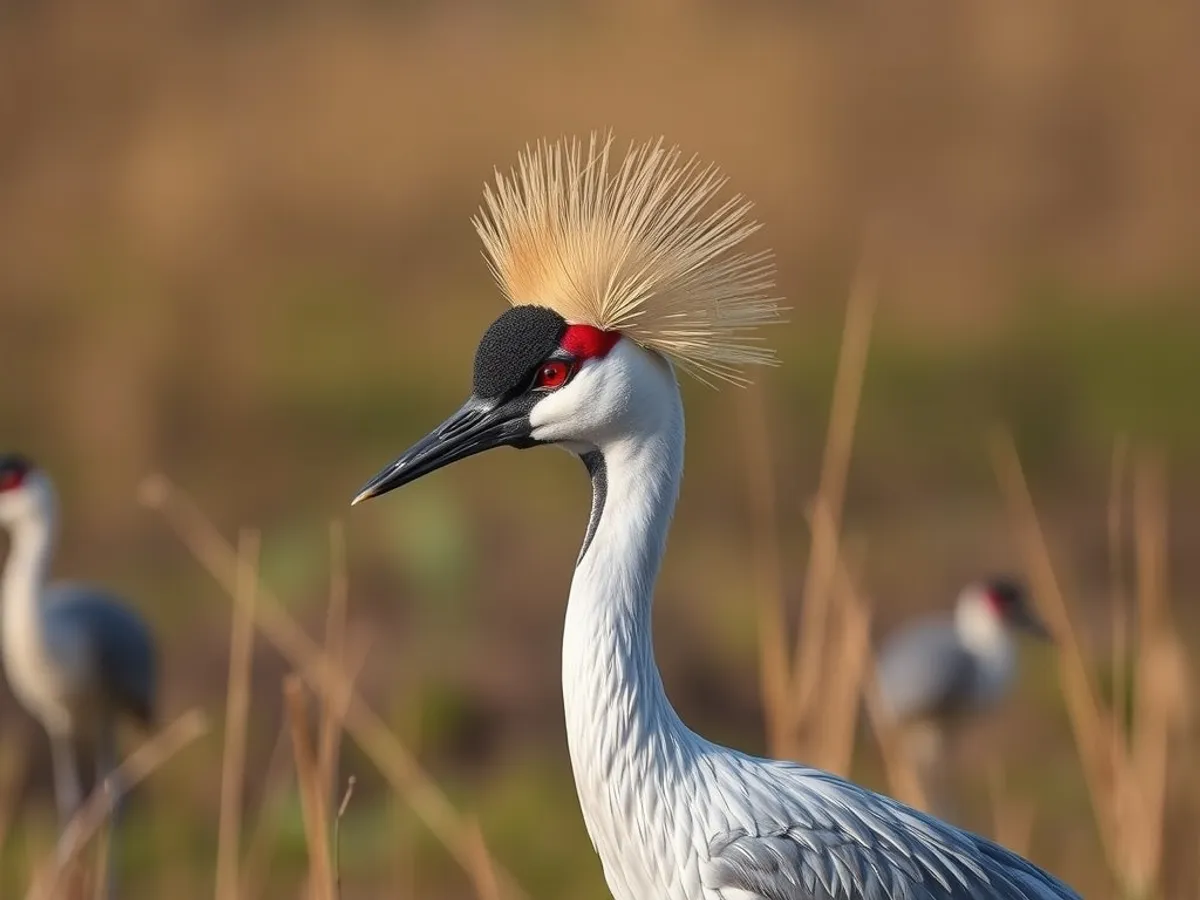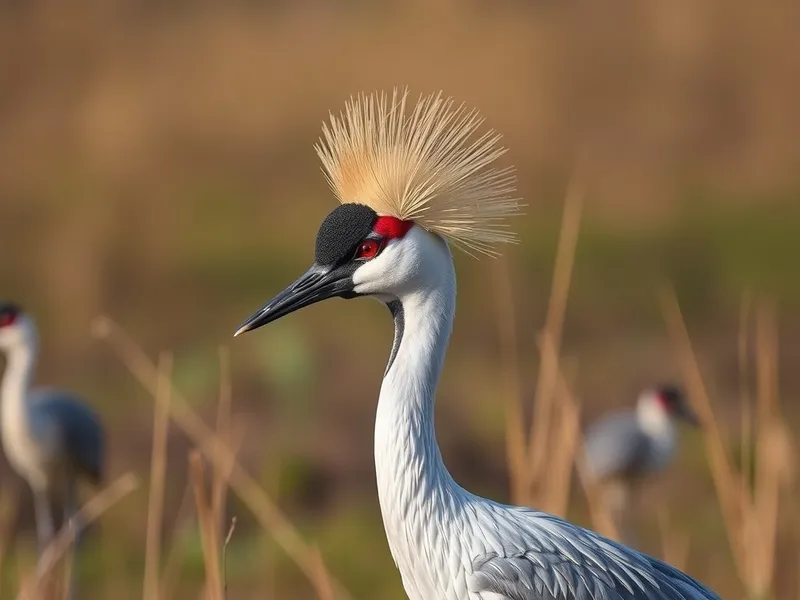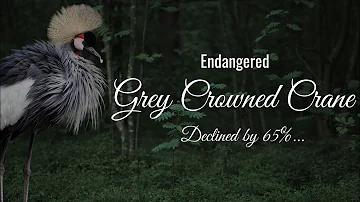
Grey Crowned Crane
Balearica regulorum

Meet the Grey Crowned Crane
The Grey Crowned Crane is an elegant, medium-sized bird known for its striking golden feathery crown. Native to the wetlands and grasslands of eastern and southern Africa, this crane is easily recognized by its grey body, white wings, and bright red throat pouch. Its elaborate courtship displays involve synchronized dancing, bowing, and leaping. Unlike most cranes, the Grey Crowned Crane is capable of perching in trees due to its long hind toe.
Classification
Bird
Habitat
Wetlands, marshes, and grasslands
Diet
Omnivore
Lifespan
22-25 years
Conservation
Endangered
Weight
3.5-4.0 kg
📖Fascinating Facts
Royal Appearance
Their golden crown of stiff feathers gives them a regal look, inspiring their name.
Dancing Displays
Grey Crowned Cranes engage in elaborate dances, including bowing, jumping, and wing flapping, to strengthen social bonds.
Tree Roosters
Unlike other crane species, they commonly perch and sleep in trees, thanks to a special long hind toe.
📋Detailed Description
The Grey Crowned Crane (Balearica regulorum) is a strikingly elegant bird, measuring 100–110 cm (39–43 in) in height with a wingspan of 180–200 cm (71–79 in) and weighing between 3–4 kg (6.6–8.8 lbs). Its most distinctive feature is the stiff golden crown of feathers atop its head, composed of long, bristle-like plumes. The body plumage is predominantly grey, with white wings that are often tinged with gold and brown, and a striking black patch on the forehead. The cheeks are white, and the bare skin on the throat forms a bright red inflatable gular sac, which is used in vocalizations and displays. Unlike most cranes, the Grey Crowned Crane possesses a long, flexible hind toe (hallux) that allows it to grasp branches and perch in trees, a trait unique among cranes. Its bill is short and pointed, adapted for foraging a wide variety of foods. The species is highly vocal, producing a distinctive booming call amplified by its gular sac, as well as honks and guttural croaks. Grey Crowned Cranes are diurnal and exhibit complex social behaviors, including elaborate courtship dances involving synchronized leaps, bows, and wing flapping. They are generally non-migratory but may undertake local seasonal movements in response to rainfall and food availability. The species forms monogamous pairs and often lives in flocks outside the breeding season, displaying a strong sense of territory during nesting.
💡 Did you know?
The Grey Crowned Crane is the national bird of Uganda and appears on the country’s flag and coat of arms.
🔬Research & Sources
Wikipedia Summary
The grey crowned crane or gray crowned crane, also known as the African crowned crane, golden crested crane, golden crowned crane, East African crane, East African crowned crane, African crane, Eastern crowned crane, Kavirondo crane, South African crane, and crested crane, is a bird in the crane family, Gruidae. It is found in nearly all of Africa, especially in eastern and southern Africa, and it is the national bird of Uganda.
Last Modified: 5/25/2025
🎭Behavior & Social Structure
Grey Crowned Cranes are omnivorous, foraging primarily in shallow wetlands and adjacent grasslands. Their diet includes insects (especially grasshoppers and locusts), small vertebrates, seeds, grains, and plant matter. They use a slow, deliberate walking gait to search for food, often stamping their feet to flush out prey. Socially, they are gregarious outside the breeding season, forming flocks of up to several hundred individuals, but maintain strong pair bonds and defend nesting territories vigorously. Daily routines involve early morning and late afternoon foraging, midday resting, and communal roosting, often in trees. Their vocalizations serve both to maintain contact within flocks and to advertise territory or pair bonds. Courtship and social displays are highly ritualized and involve both sexes. Juveniles remain with parents for several months, learning foraging and social behaviors.
👶Reproduction & Life Cycle
Grey Crowned Cranes are monogamous, forming long-term pair bonds. Breeding is closely tied to the onset of the rainy season, which varies across their range. Courtship involves elaborate displays of dancing, bowing, and mutual calling. Nests are constructed by both sexes in tall wetland vegetation, typically as large platforms of grasses and reeds. The female lays 2–5 eggs, which are incubated by both parents for 28–31 days. Chicks are precocial, leaving the nest within a day of hatching but remaining under parental care for up to 10–12 weeks. Both parents feed and protect the chicks, which fledge at about 56–100 days. Reproductive success is highly dependent on wetland conditions and predation pressure.
🛡️Adaptations & Survival
The Grey Crowned Crane’s unique hind toe enables it to perch in trees, providing safety from ground predators and access to roosting sites. Its omnivorous diet and foraging versatility allow it to exploit a wide range of habitats, from flooded wetlands to dry savannas. The golden crown of feathers is used in social and courtship displays, signaling fitness and species identity. The inflatable gular sac amplifies vocalizations, aiding communication over long distances in open habitats. Their long legs and toes are adapted for wading in shallow water, and their strong wings allow for agile flight and short-distance dispersal.
📚Research Sources
🎨Cultural Significance
The Grey Crowned Crane holds significant cultural value across its range, most notably as the national bird of Uganda, where it appears on the national flag and coat of arms as a symbol of elegance and prosperity. In various African cultures, the crane is associated with longevity, fidelity, and peace, and its courtship dance is sometimes incorporated into traditional ceremonies. Feathers and images of the crane are used in art, folklore, and rituals, though direct use in traditional medicine is less common than for some other species. The bird’s beauty and charisma make it a flagship species for wetland conservation in Africa.
🔬Recent Research & Discoveries
Recent research has focused on the Grey Crowned Crane’s genetic diversity, population structure, and movement ecology using satellite telemetry. Studies have highlighted the importance of small, fragmented wetlands for breeding and the species’ sensitivity to hydrological changes. Conservation genetics research indicates low genetic differentiation between subspecies (B. r. gibbericeps and B. r. regulorum), suggesting recent divergence. Ongoing projects are investigating the impacts of agrochemicals and land-use change on reproductive success and chick survival. Community-based conservation programs in East Africa are showing promise in reducing nest disturbance and promoting sustainable wetland management.
🎥Wildlife Videos

About Grey Crowned Crane | Wild Life Explore
Elegant, majestic, and crowned like royalty — today, we're diving into the fascinating world of one of Africa's most iconic birds: the ...
Wild life Explore

The Grey Crowned Crane: Beauty in Motion
The Grey crowned crane, also known as the African crowned crane, is a large bird that belongs to the crane family. It is easily ...
Familiarity With Animals (FWA)

Endangered Bird of Africa: Magnificent Grey Crowned Crane
The Grey Crowned Crane (Balearica Regulorum) is an endangered bird in the Crane family, Gruidae. It is also the National bird of ...
Nature's Cry

Black, Red and Gray crowned crane(Discover the Majestic Gray Crowned Crane!
Black, Red and Gray crowned crane(Discover the Majestic Gray Crowned Crane! Get ready to be mesmerized by the majestic ...
Animal HD 66

Grey crowned crane Descriptions, Characteristics and Facts!
Hi, this is animal planet tv channel. Grey crowned crane Descriptions, Characteristics and Facts! my channale name animal planet ...
animal planet tv

China's Love of Cranes | The Forbidden River
About National Geographic Wild: National Geographic Wild is a place for all things animals and for animal-lovers alike. Take a ...
Nat Geo Animals
🌍Habitat Information
The Grey Crowned Crane typically inhabits Wetlands, marshes, and grasslands environments. Grey Crowned Cranes have adapted to their environments with specialized features and behaviors.
Primary Habitat:
Wetlands, marshes, and grasslands
More detailed habitat information will be available soon.
🛡️Conservation Status
The Grey Crowned Crane is currently classified as Endangered. Conservation efforts are crucial for preserving this species for future generations.
Common Threats:
- 🏠Habitat loss and fragmentation
- 🌡️Climate change impacts
- 🎯Hunting and poaching
- 🏭Human-wildlife conflict
⚠️Threats & Conservation Challenges
The Grey Crowned Crane is classified as Endangered by the IUCN, with global populations estimated at 25,000–30,000 and declining. Major threats include habitat loss and degradation due to wetland drainage, agricultural expansion, and overgrazing. Illegal capture for the pet trade and use in traditional medicine, as well as egg collection, further impact populations. Pesticide use and pollution reduce food availability and cause direct mortality. Human disturbance during breeding can lead to nest abandonment. Climate change poses additional risks by altering rainfall patterns and wetland hydrology. Conservation efforts are hampered by insufficient legal protection and enforcement in many range countries.
🔬Scientific Classification
Scientific Name
Balearica regulorum
Classification Hierarchy
🔍 About Taxonomic Classification
Taxonomic classification is a hierarchical system used by scientists to classify and organize living organisms based on shared characteristics and evolutionary relationships.
The system moves from broad categories (Kingdom) to increasingly specific ones, with each animal's scientific name typically consisting of its Genus and species.
📝Community Notes
Share your observations and insights about the Grey Crowned Crane with our community of wildlife enthusiasts.
Join Our Community
Sign in to share your observations and connect with fellow wildlife enthusiasts.
Sign In to ContributeNo community notes yet
Be the first to share your observations about the Grey Crowned Crane!
Explore Grey Crowned Crane
Select a tab above to learn more about this amazing animal.
📸Photo Gallery
No photos available for this animal yet.
🌟Discover More Wildlife
Continue your journey of discovery with more fascinating animals from our database
